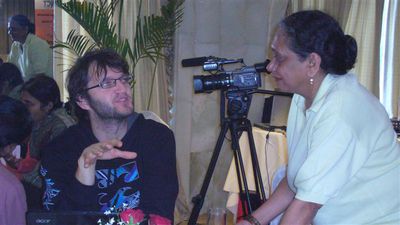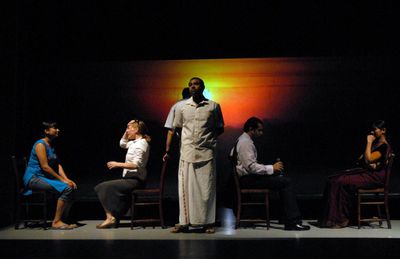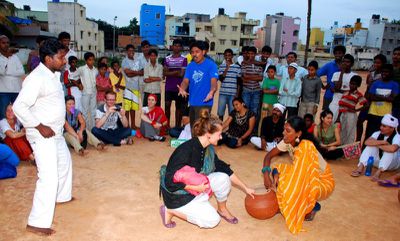29 Mar 2012
A Small, Small World: Living with Difference in Intercultural Theatre

In early 2011, I had the good fortune of collaborating with two of the finest theatre makers I have known, Konradin Kunze and Sophia Stepf, both from Germany. We worked together on a devised theatre piece called A Small, Small World, which was based on the life of Hamidur Rahman.
The project had taken seed in Konradin’s mind much earlier. While he was an actor at the Schauspielhaus, The State Theatre in Hamburg, Konradin was drawn to the story of Hamidur Rahman, a Bangladeshi national, which he had come across in a newspaper.
Hamidur Rahman had applied for asylum in Germany, and claimed to be a political activist in his country. The German authorities had interviewed him several times and rejected his application more than once. This caused turbulence in Rahman’s marital life, which eventually led to divorce. His wife took custody of their son. In a span of three years he had lost not only his legal status and family, but also his mental balance. In desperation, Rahman tried to cross Greenland on foot, in an attempt to reach Canada and seek asylum there. He collapsed on the way and was coincidentally rescued by a helicopter that had lost its way in bad weather. Soon after his return to Germany, Rahman committed suicide.
[caption id="attachment_20204" align="alignnone" width="300" caption="Konradin Kunze in 'A Small, Small World' (Photo credit: Saumya Pratik)"]
I was approached by Sophia Stepf, Konradin’s partner and fellow theatre maker, with the idea of working together to create a piece of documentary theatre in English, German and Bengali. I agreed to be part of this project purely because I believed in Sophia as a person and in her vision of the play. To be honest, I did not quite completely understand the nature of our collaboration at that stage.
The three of us met in December 2010 in Bangalore. During this meeting, Kunze explained to me his liking for the form of stop-motion and hence his desire to make a small set which would be projected on to a screen. I could not see the strength of his idea at that time, but from the clips he showed me of his previous work, I could tell that he was a master of the form.
We arrived in Bangladesh two weeks’ later and plunged into research. We soon realised that our divergent understanding of the context was beginning to play a pivotal role in the way we were responding to our research. With every step of the research, I became increasingly distrustful of Rahman’s story and I could not understand Konradin and Sophia’s inherent sympathy for Rahman.
[caption id="attachment_20205" align="alignnone" width="300" caption="Abhishek Majumdar in 'A Small, Small World' (Photo credit: Saumya Pratik)"]
 [/caption]
[/caption]As the trip progressed, we found ourselves occupying opposite positions. Kunze and Stepf were documenting a man who had tried his best to make his place in the world and I was convinced that Rahman was essentially a goon of the Awami League (one of two major political parties in Bangladesh) who might have broken several laws. I perceived cruelty and misplaced ambition, and though I was interested in the story, I had little sympathy for Rahman.
On returning to India we found our rehearsals coming to a halt time and again. There were days when we just could not proceed and we began to realise that our positions on Rahman were so different that it was almost impossible to tell the same story. We tried to get more information about Rahman’s involvement with the Awami League in the hope of getting to know more about the nature of his political crime.
After a few days, in a completely random conversation, we realised that we had two different pictures of what a ‘party worker’ meant. To my German colleagues a party worker was someone who wore a tie and suit and went about distributing party literature and discussing politics. To me, an Indian, a party worker was someone who forced people to vote, to donate money—someone who was essentially a glorified goon. Our greatest problem was that there was no way of resolving our differences.
At this point we thought of calling the play off or having Konradin do a solo performance. But Konradin was not in favour of dropping the collaborative nature of the play and it was practically impossible to call the play off because commitments had been made to theatres and organisations. After much debate and deliberation we came to the consensus that I would perform too, but not take credit as a writer, because what we were performing was not my version of the story. Konradin also decided to add a short monologue where he openly refers to the problem of authenticity in Rahman’s story and acknowledges the basic limitations of the storyteller. This was in response to our discussions and our inability to gather enough information to construct an alternative narrative.
[caption id="attachment_20206" align="alignnone" width="300" caption="Photo credit: Saumya Pratik"]
 [/caption]
[/caption]What I found most interesting was that the day we decided to commit to going ahead with whatever we had, our work became collaborative in the truest sense. We leapt at ideas in the rehearsal room. We began to get on to the floor and make suggestions about staging and scripting. The process became thoroughly organic and our true strengths came to the fore. Suddenly, we began to work as a really strong team of artists and the excitement in the rehearsal room was palpable.
Konradin and I played multiple roles in the production. We played Rahman’s family, German officials, journalists he met in Europe, immigration officers in Denmark and several other people who were involved in his story. We also played ourselves. Our theatre selves, with our doubts about the play, our doubts about each other, and even the many cultural jokes we cracked about each other in rehearsals, found their way into the play.
The sets of the different locales were created on a small table using cardboard and thermocol and the images were projected on to a screen at the back of the stage using a live camera and a projector. Konradin and I inhabited the various places to which Rahman travelled by changing the set on the table and playing off the screen. Konradin’s idea of using this aspect of stop-motion animation worked wonderfully.
We did shows in Bangalore and travelled to Bangladesh and Germany with the production. We also did shows elsewhere in India. The response of the audience was different in each place. Indians, by and large, appreciated the form of the production. The Germans and Bangladeshis responded to it emotionally. They saw it as their story—their struggle and guilt, portrayed.
I continued to perform the play, since I had committed to Konradin and Sophia, and they continued to put up with my disagreement, since they had committed to me. But beyond the question of commitment, we had developed a relationship. We had learnt to respect our differences and to agree that we did not have to agree. We gave the audience a play worth watching, I believe, and by the end of this fabulous play, we had succeeded in achieving something very precious to me: to understand, at a profound level, that this is indeed a small, small world. We came to accept that there were things about which we could never agree, yet understood that what had brought us together was far more meaningful than our disagreements: our common love for storytelling. Once we were able to trust each other completely, we surrendered to our love for storytelling. This shared passion has encouraged us to look for other stories that could bring us together again. We continue to discuss ideas and actively plan for our next endeavour to devise theatre collectively.
Abhishek Majumdar is a playwright, actor and director based out of Bangalore. Currently he is the artistic director of the Indian Ensemble . He is an alumnus of the London International School of Performing Arts.
Similar content
posted on
11 Apr 2012
posted on
15 Jun 2010
posted on
28 Sep 2010
posted on
19 Jan 2012
posted on
04 Apr 2012
posted on
16 Jul 2014





